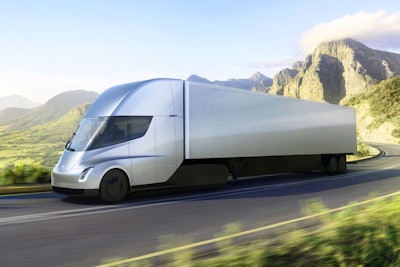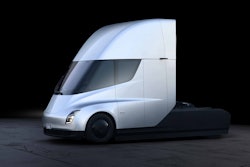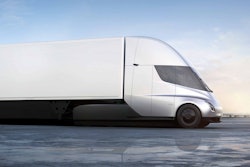 The Tesla Semi $150,000 base model will have a 300-mile range. The $180,000 model will have a 500-mile range.
The Tesla Semi $150,000 base model will have a 300-mile range. The $180,000 model will have a 500-mile range.How would you like to get an extra dollar for every five miles you drive? That’s one of many notable promises made by Tesla Motors at the unveiling of the electric Tesla Semi.
The boast gets at the heart of what owner-operators care the most about: Would this equipment save me serious money? That question traditionally hinges on not just fuel efficiency, but also truck price and maintenance costs.
Price was one of the glaring omissions at the debut, though days later Tesla announced a range of $150,000 to $200,000. That’s not as high as some people expected, given another glaring unknown, the specs of a battery that could handle a range of up to 500 miles. Observers’ estimates of battery cost alone have exceeded the cost of a new diesel tractor, but apparently Tesla figured a way around that.
Even if it’s not too costly, if the battery is too big or heavy, it takes away too much cargo space or payload. That makes it perhaps the biggest question mark in the undisclosed math behind a key comparison Tesla announced: The Semi will have operational costs of $1.26 per mile vs. $1.51 for a typical diesel tractor. That’s a 16.6 percent savings.
A big part of that is fuel savings – that extra dollar per five miles or, as Tesla put it, $200,000 over a million miles. That involves at least two major variables – future prices for diesel and electricity – and the truck won’t even be available until 2019. Electricity’s cost history has been relatively stable, unlike the volatility of oil-based fuels. If anything goes wacky regarding the relative prices of electricity and diesel, it likely won’t be electricity to blame.
It will be years before Semis pound enough asphalt to determine true maintenance costs. Nevertheless, the manufacturer has grounds for claiming big maintenance savings. Namely, the four motors powering the drive axles are far simpler than today’s complex diesel engines. Gone are the transmission, differential and exhaust treatment system. On the other hand, chief Elon Musk was also quiet on pre-production testing and plans for a nationwide service network, implying some naivete about being prepared for the many things that can go wrong with a truck.
Yet Musk is hardly alone in chasing this holy grail. The startup Nikola said months ago it had orders for 8,000 of its hydrogen-electric tractors. More established brands – including Daimler, Cummins, Mack, Peterbilt, Kenworth, Navistar, Volkswagen and Toyota – have shared their development efforts with electric power.
Diesel power will be around probably for decades. But don’t be shocked if you live to see e-trucks as a common sight – not just for saving the environment but for saving costs.
As for the design features of the Semi, Overdrive Equipment Editor Jason Cannon, who attended the Semi’s unveiling, offers his impressions in the following video.











